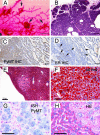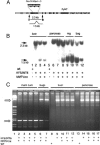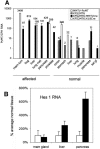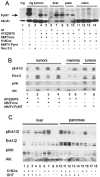Differential sensitivity of mouse epithelial tissues to the polyomavirus middle T oncogene
- PMID: 16400032
- PMCID: PMC1592648
- DOI: 10.2353/ajpath.2006.050443
Differential sensitivity of mouse epithelial tissues to the polyomavirus middle T oncogene
Abstract
To determine how different epithelial cell types respond to the same oncogenic stimulation, we have used a modified human keratin 18 gene to conditionally express the polyomavirus middle T antigen (PyMT) oncogene in simple epithelial tissues of transgenic mice. Activation of PyMT expression by transgenic Cre recombinase in mammary epithelial cells resulted in carcinomas in all bitransgenic females. PyMT expression induced by K18-driven Cre in internal epithelial organs resulted in pancreatic acinar metaplasia and ductal dysplasia with remarkable desmoplastic stromal responses in all 25 bitransgenic mice. Hepatoma formation with altered lipid metabolism and gastric adenocarcinoma occurred in 96 and 54% of these mice, respectively. Elevated PyMT RNA expression also correlated with intraepithelial neoplasia in the prostate. Activated Erk2 was found in mammary tumors, pancreatic tissues, and affected livers. Hes1 RNA, a target of Notch signaling that has been implicated downstream of Ras pathway activation, was elevated in pancreatic and liver lesions. The variety of responses of different epithelia to PyMT demonstrates the importance of the differentiated state in interpreting oncogenic signals.
Figures







References
-
- Cardiff RD, Rosner A, Hogarth MA, Galvez JJ, Borowsky AD, Gregg JP. Validation: the new challenge for pathology. Toxicol Pathol. 2004;32(Suppl 1):31–39. - PubMed
-
- Namba R, Maglione JE, Young LJ, Borowsky AD, Cardiff RD, MacLeod CL, Gregg JP. Molecular characterization of the transition to malignancy in a genetically engineered mouse-based model of ductal carcinoma in situ. Mol Cancer Res. 2004;2:453–463. - PubMed
-
- Williams RL, Courtneidge SA, Wagner EF. Embryonic lethalities and endothelial tumors in chimeric mice expressing polyoma virus middle T oncogene. Cell. 1988;52:121–131. - PubMed
Publication types
MeSH terms
Substances
Grants and funding
LinkOut - more resources
Full Text Sources
Molecular Biology Databases
Research Materials
Miscellaneous

